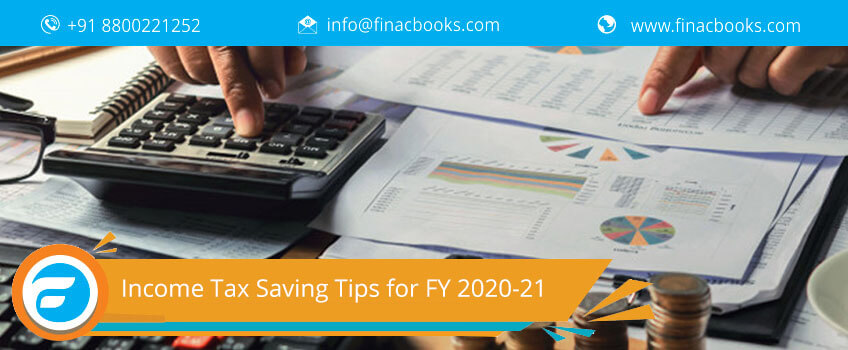Income Tax Return for FY 2019-20
As we know that less than one month is remaining to file an income tax return for FY 2019-20 but tax planning has already been started for the FY 2020-21. Due to lots of investment and tax planning options, there is a lot of confusion among the taxpayers that how they can save maximum of their tax in FY 2020-21. In this blog, we will talk about various options that help you save maximum tax in this financial year and also prepare you for FY 2020-21.

Which tax structure to choose from?
Your income makes you decide which tax structure is best for you (old or new one) in FY 2020-21. If you can claim more from deductions, investments such as paying rent, getting a home loan etc., it’s better that you should follow the old structure, especiallythose persons who fall in the higher income-tax bracket.
Change of tax structure
Salaried person v/s Business owner – Whatever structure (old or new), you will select as a salaried person this financial year, you can easily change the same next year whereas as a business owner, you can’t change it and have to follow the same tax structure (old or new) in next year too.
Tax Saving: New versus old structure
Tax saving as per new tax structure
As per the new tax structure, you don’t have so many tax saving options with you. You cannot avail any deductions and exemptions as per the new tax structure and the only benefit you can access here is National Pension system (NPS). The salaried employees can only avail this deduction.
NPS benefit
Under section 80CCD(2), you can get a tax rebate on the amount contributed by your employer in NPS. You can claim up to 10% of your basic salary plus DA on the amount your employer has contributed towards NPS. This can only be possible if your company give you a choice of restructuring your salary.
Tax saving as per old tax structure
If you have enough options with you to claim the deduction, follow the old tax structure. You can claim the following deductions under the old tax structure –
Standard tax deduction
It is a statutory deduction of Rs.50000 allowed to every taxpayer which an individual can claim while filing his or her tax return.
House rent allowance (HRA)
Salaried individuals who live in rented houses are eligible to claim house rent allowance (HRA). Claiming of house rent allowance depends upon how much salary you are getting and how much rent you are paying to your landlord. There is no limit specified by the income tax department on House Rent Allowance (HRA). If you are drawing a handsome salary and paying a good amount of rent, you can claim a good amount of HRA.
Home loan tax deduction
Home loan tax deduction is the second way by which you can claim the maximum amount of tax deduction i.e. up to Rs.5 Lakh. It includes two components -
Principal deduction
Principal deduction has an overall limit of Rs.1.5 Lakh. If you make repayment of more than Rs.1.5 Lakh, you can claim the full amount under the section 80C.
Interest deduction
Interest deduction comes under section 24 and covers interest/loss from the property. If you have taken a home loan for your self-occupied property, you can claim deduction on your home loan interest up to Rs.2 Lakh in a particular financial year whereas if you have taken a home loan and rented out the property or notbut if you are not living there, it will be considered as “Deemed let-out” and you have to add the rent in your income on the basis of the market rate.
In the case of property loss, ifthe outflow of the interest is higher than the rent you are receiving, you can claim loss of property up to Rs.2 lakh under section 24.
Additional deduction
If you have purchased your home under affordable housing (Property value less than Rs.45 Lakh) in FY 2019-20, for which you have taken a home loan in FY 2019-20, you will also get a deduction up to Rs.1.5 Lakh under section 80EEA. This can be taken over and above the deduction of Rs.2 Lakh under section 24. In case the property is jointly purchased, suppose by husband and wife and they both are filing tax returns, then both of them are entitled to claim tax deduction separately in their tax returns.
Educational loan (Section 80E)
Education loan is also one of the components which help you save much of your income tax. If you have taken a higher education loan after 12th, you can claim the interest component of the loan as a deduction and there is no limit specified by the government on the deduction either you are studying in India or abroad. You can take this loan for self, spouse or children as well. You can claim this deduction maximum up to 8 years.
Investments
If you have not opted for a home loan or education loan, then you can save much of your tax by investing your money in the following ways -
Section 80C
Section 80C allows the taxpayers to claim the overall deduction of Rs.1.5 Lakh from the total income.
EPF for salaried employees - In case of Employee Provident Fund (EPF), you will get returns of 8-9%, which is non-taxable. A salaried employee can only use this fund if he/she has left the job or upon the retirement.
Home loan Principal - Home loan principal is also covered under Section 80C. Sometimes, you have been told to buy the product for the benefit of tax relief but if you have already saved taxes up to Rs.1.50 Lakh, see this product independently on the basis of overall return and don’t buy that product just for tax saving.
Tuition fee - Another component in which you don’t have to make an extra investment is School Tuition fee, which also comes under section 80C, For example – Children’s school or college tuition fees.
Life Insurance premium - We should not mix up insurance and investment. So, it’s better you should go for Term insurance. You will find only 5-6% returns in Endowment plans of life insurance premium, which is quite less. You can claim the term insurance premium under section 80C and you can make the rest of the investments in mutual funds, stocks, real estates as per your choice.
ELSS (Equity linked saving scheme) – It is a tax saving mutual fund having a lock-in period of 3 years (which isthe lowest lock-in period under section 80C). You will get high returns from mutual funds, which can be a 13-14% return. The returns earned from mutual funds or stock market gains can only get taxable if the amount is more than Rs.1 Lakh.
Fixed Income deposits – You will receive fixed returns under fixed income deposits. For example - If you have a daughter, you can opt for Sukanya Samriddhi Scheme, It gives you 8-9% return, which is tax-free but you cannot withdraw money till the time your daughter attains the age of 21 years. You can also invest in retirement products like Public provident fund (PPF) and voluntarily provident fund and can get 8-9% return after the lock-in period of 15 years.
Other deposits - You can also invest your money in other deposits like Post office deposits, National saving certificates, Senior citizen deposits, Tax saving schemes.
Section 80D – Health insurance premium
Section 80D allows you to claim tax deduction on the medical insurance premium paid for self, parents, spouse and children. If you have opted health insurance for self or dependent family members, you can claim a deduction of Rs.50000 – Rs.1 Lakh on the health insurance premium.
Section 80G – Donations
Section 80G allows individuals to claim deduction on the contribution made by them towards certain relief funds and charitable institutions. If you have made any taxable donation, you are allowed to claim such deduction under section 80G.
I hope these tips will help you in claiming various deductions while filing the income tax return and save maximum of your income tax in FY 2020-21.











